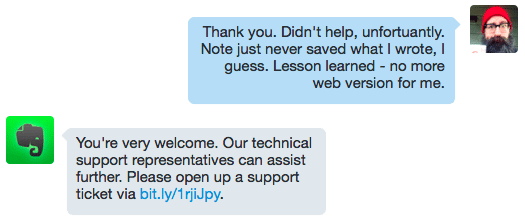Today we’ve got a new ‘guest writer!‘ He’s an old friend who I get together with every once in a while and discuss marketing, social media, the internet, music and a bunch of other stuff! His name is Seth W. I recently subscribed to Seth’s newsletter and his latest article was perfect! To be honest, after my recent vacation I was mentally preparing to write an article about customer service. I got home and Seth’s article was in my inbox and, well, he did a better job than I could have. So…I asked Seth if I could feature him as a ‘guest writer!’ I am honored to share some of his knowledge to you!
Seth W’s Accomplishments / Links: Seth W [dot] com | Twitter | Skulltoaster | Workbench Insider
I was asked to complete a “written assignment” for a job application recently, and figured I’d share what I wrote.
SETH W.’S BELIEFS ABOUT CUSTOMER SERVICE
Or, “Can a coffee shop make you feel dumb?”
When I think of super customer service, I think of the overall feeling I get when I walk away from a business or a brand. Do I walk away feeling duped or cared for? Do I feel energized, and stoked to share their story? Or does the process make me feel like throwing my hands in the air and living in the woods like a hermit?
For me, it starts with authenticity.
Who works at Apple stores? APPLE PEOPLE.
I remember when I switched from a PC back in 2003, and how passionate the Apple employees were. It’s like they’d be there even if they weren’t paid. They answered my dumb questions I had about moving from Windows. They showed me how to do simple tasks, shared their experiences, and other Apple employees always joined in the conversation.
That’s authentic. There’s no script, no rehearsed language, they were just stoked!
And then recently, more than a decade later, I’m buying one of those Joby GorrilaPod’s at an Apple store, and it happened again; another employee came up right in the middle of my transaction and was like, “yes! These are awesome,” and he told me all about how he uses it for making videos.
It’s hard to teach that.
So to me, speaking from a place of authenticity just leads to deeper conversations, and better interactions. Why would a company not hire devout fans to come work on their team?
Second, I believe empathy is vital in customer support. Just recently Evernote let me down. I’ve been a die-hard Evernote since about 2009, but recently we had a falling out, and we’re not really talking at the moment. Just kidding; I can’t live without Evernote.
Here’s what happened; I lost a few hours of work, and their support was nonchalant about it. Nonchalant?! Wait, what?
It took three days for them to reply to my DM. Then when I told them my work was lost, their response lacked any sort of feeling:

How did they think that anyone who lost hours worth of work would be okay with reading, “you’re very welcome,” or being told about, “technical support representatives?”
I understand they can’t perform magic and bring back my note from the dead, but they can have some heart! It totally didn’t feel like anyone was going to bat for me here, which is a bummer.
Lastly; curiosity. When Evernote launched their new web-version back in October, I got to talking with Joshua Taylor, Design Director of Evernote.

We swapped a few emails, where I explained a few things I would love to see. He would reply, and asked me deeper questions; asking how I did certain things on the desktop app, and why. He asked about my work flow.
Joshua, a design director who probably has enough “action items” on his list, served the customer here much better than my recent “customer service” interaction. He was curious, and wanted to know my thoughts. No web-form, or a, “let us know what you think!” survey. He was monitoring who replied to the @evernote account, and asking questions.
He’s one of the reasons I continue to use Evernote, because I know there’s some great people there doing amazing things.
All these things add up to being human.

The fun part about a company like MailChimp sending me a hat, or a design director taking the time to email a user, is that it’s tough to scale, and that’s exactly why I believe it needs to happen more. If it’s hard to do, it’s worth doing more of it.
Like Seth Godin says, “the problem with the race to the bottom is that you might win.”
You can compete with Starbucks on price, or you can open a cute shop in town, play some records, and have authentic conversations with everyone who walks through the door.
You could fully automate your support process with robots, but robots don’t know what it feels like to lose 20,000 photos when a hard drive fails.
The restroom door of your cool coffee shop can be minimally labeled “WC,” or 75% of your customers might mistakenly walk into the utility closet. At a small coffee shop in my hometown I see this all the time. You should see the look on their faces. They say things like, “ooops!” and “oh my god,” as they quietly close the door and slink away.
You could set up one of those annoying, “say the name of the department you wish to speak with” phone systems, or a real person could answer the phone, and discover together the best course of action (I’d read that everybody at CD Baby can answer the phone when it rings – how exciting!)
Yes, customer service can just be about helping people do stuff, like buying shoes, finding the restroom, or embedding a video. All of this can be automated to some degree, but with just a bit more effort the experience can be humanized, and those interactions can find their way into conversations with friends, or written assignments like this one!
Just think about how the vague “customer service” title can relate to what you do. You’re serving readers, right? Or an audience? Clients?
You don’t tune at full volume on stage, right? RIGHT?! Do you reply to client emails at 1:24am in bed when you’re half asleep?
I like this quote from Don Clark, of Invisible Creature:
“Crafting an email is almost as important as crafting an illustration“
It’s like the new, hip food joint in town; fancy sign, big PR campaign, a photo booth, but then a hand-written sign in the window with the store hours.
Details matter to your customers / fans / clients. Pay attention.
PS – I’ll let you know if I get the job.
PPS – I started doing The Workbench Podcast with my friend Bill Meis, where we talk about doing good work using the internet. We just uploaded episode #3 today.
– Seth Werkheiser

